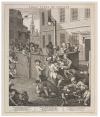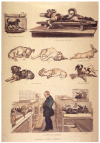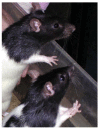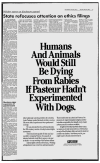Animal Experiments in Biomedical Research: A Historical Perspective
- PMID: 26487317
- PMCID: PMC4495509
- DOI: 10.3390/ani3010238
Animal Experiments in Biomedical Research: A Historical Perspective
Abstract
The use of non-human animals in biomedical research has given important contributions to the medical progress achieved in our day, but it has also been a cause of heated public, scientific and philosophical discussion for hundreds of years. This review, with a mainly European outlook, addresses the history of animal use in biomedical research, some of its main protagonists and antagonists, and its effect on society from Antiquity to the present day, while providing a historical context with which to understand how we have arrived at the current paradigm regarding the ethical treatment of animals in research.
Keywords: animal ethics; animal research; animal testing; biomedical research; history of science.
Figures







Similar articles
-
Public perception of laboratory animal testing: Historical, philosophical, and ethical view.Addict Biol. 2021 Nov;26(6):e12991. doi: 10.1111/adb.12991. Epub 2020 Dec 16. Addict Biol. 2021. PMID: 33331099 Free PMC article. Review.
-
Culture of Care: Organizational Responsibilities.In: Weichbrod RH, Thompson GA, Norton JN, editors. Management of Animal Care and Use Programs in Research, Education, and Testing. 2nd edition. Boca Raton (FL): CRC Press/Taylor & Francis; 2018. Chapter 2. In: Weichbrod RH, Thompson GA, Norton JN, editors. Management of Animal Care and Use Programs in Research, Education, and Testing. 2nd edition. Boca Raton (FL): CRC Press/Taylor & Francis; 2018. Chapter 2. PMID: 29787190 Free Books & Documents. Review.
-
Openness in Scientific Research: A Historical and Philosophical Perspective.J Open Access Law. 2023 Sep 21;11(1):132. J Open Access Law. 2023. PMID: 37994350 Free PMC article.
-
[The use of transgenic animals in biomedical research in Germany. Part 2: Ethical evaluation of the use of transgenic animals in biomedical research and perspectives for the changeover in research to research animal-free methods].ALTEX. 2006;23(1):3-16. ALTEX. 2006. PMID: 16477343 Review. German.
-
Biomedical ethics policy in Korea: characteristics and historical development.J Korean Med Sci. 2012 May;27 Suppl(Suppl):S76-81. doi: 10.3346/jkms.2012.27.S.S76. Epub 2012 May 18. J Korean Med Sci. 2012. PMID: 22661876 Free PMC article.
Cited by
-
A Structured Approach to Optimizing Animal Model Selection for Human Translation: The Animal Model Quality Assessment.ILAR J. 2021 Dec 31;62(1-2):66-76. doi: 10.1093/ilar/ilac004. ILAR J. 2021. PMID: 35421235 Free PMC article.
-
The Emperor's New Clothes-An Epistemological Critique of Traditional Chinese Veterinary Acupuncture.Animals (Basel). 2019 Apr 15;9(4):168. doi: 10.3390/ani9040168. Animals (Basel). 2019. PMID: 30991678 Free PMC article.
-
Camera-Based Respiration Monitoring of Unconstrained Rodents.Animals (Basel). 2023 Jun 7;13(12):1901. doi: 10.3390/ani13121901. Animals (Basel). 2023. PMID: 37370412 Free PMC article.
-
An Invertebrate Host to Study Fungal Infections, Mycotoxins and Antifungal Drugs: Tenebrio molitor.J Fungi (Basel). 2018 Nov 12;4(4):125. doi: 10.3390/jof4040125. J Fungi (Basel). 2018. PMID: 30424549 Free PMC article. Review.
-
Puncture versus capture: which stresses animals the most?J Comp Physiol B. 2020 May;190(3):341-347. doi: 10.1007/s00360-020-01269-2. Epub 2020 Feb 25. J Comp Physiol B. 2020. PMID: 32100057
References
-
- von Staden H. Herophilus: The Art of Medicine in Early Alexandria. Cambridge University Press; Cambridge, UK: 1989.
-
- Court W.E. Pharmacy from the ancient world to 1100 AD. In: Anderson S., editor. Making Medicines: A Brief History of Pharmacy and Pharmaceuticals. Pharmaceutical Press; London, UK: 2005.
-
- Maehle A.-H., Tröhler U. Animal experimentation from antiquity to the end of the eighteenth century: Attitudes and arguments. In: Rupke N.A., editor. Vivisection in Historical Perspective. Croom Helm; London, UK: 1987.
-
- Geller M.J. Phlegm and breath—Babylonian contributions to hippocratic medicine. In: Finkel I.L., Geller M.J., editors. Disease in Babylonia. Brill; Leiden, The Netherlands: 2007.
-
- Guerrini A. Experimenting with Humans and Animals: From Galen to Animal Rights. Johns Hopkins University Press; Baltimore, MD, USA: 2003.
Publication types
LinkOut - more resources
Full Text Sources
Other Literature Sources

